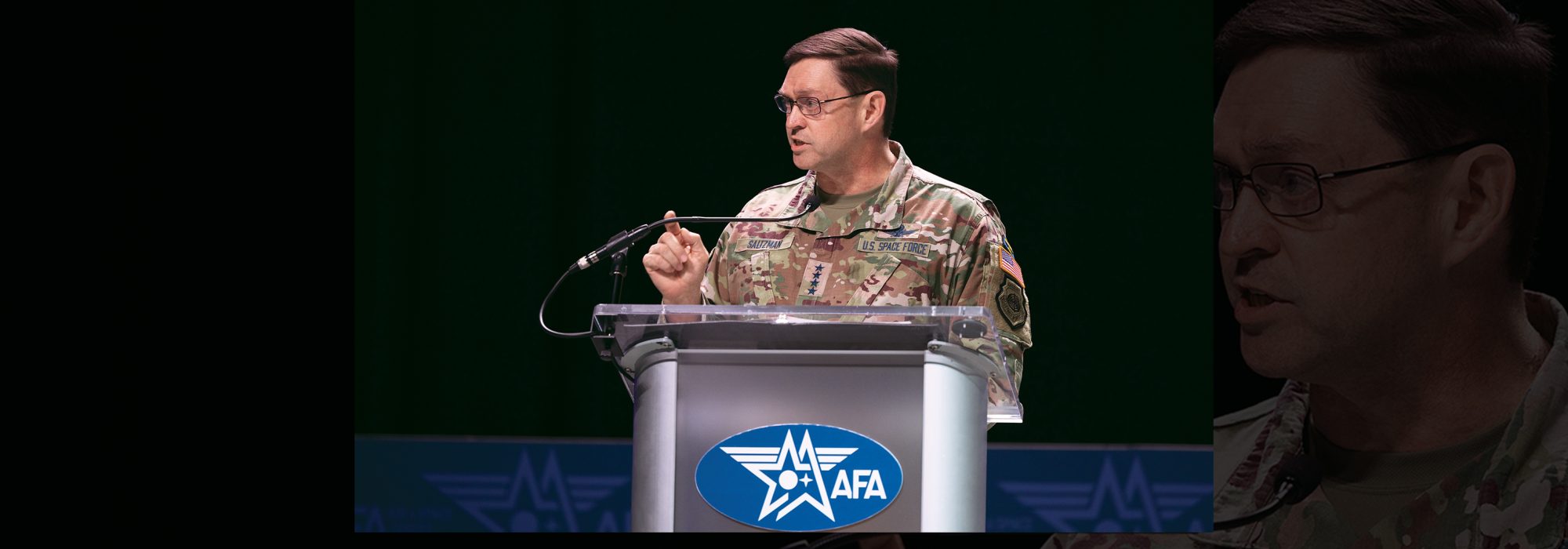Space Superiority Takes Center Stage
By Greg Hadley
Looking into the future in 1957, then-Maj. Gen. Bernard A. Schriever predicted that “in the long haul, our safety as a nation may depend upon our achieving ‘space superiority.’”
Now, nearly 70 years later, Chief of Space Operations Gen. B. Chance Saltzman is making the case for space superiority in a bold new way, breaking with decades-old tradition and openly talking about destructive force in space.
“The Space Force will do whatever it takes to achieve space superiority,” he said at the 2025 AFA Warfare Symposium. He called for the Space Force to invest in every possible way to achieve “space control.”
Space Force leaders quickly picked up on his lead, echoing his objective to control the space domain—and to do so with destructive force, when necessary.
“Space control encapsulates the mission areas required to contest and control the space domain, employing kinetic and nonkinetic means to affect adversary capabilities by disruptions and degradation—even destruction if necessary,” Saltzman said. “It includes things like orbital warfare, electromagnetic warfare. Its counterspace operations can be employed for both offensive and defensive purposes, at the direction of the combatant commands.”
Just Like Any Other Service
Analysts and academics increasingly have noted the need for offensive space weapons and senior Space Force leaders had been more willing to comment on the topic in the recent past. Saltzman, for example, previously referred to “responsible counterspace campaigning,” while U.S. Space Command boss Gen. Stephen N. Whiting has said having recourse to “space fires” was among his top priorities.
Yet as recently as September, U.S. Space Force leaders skirted direct references to applying force in space. In March, USSF leaders were more at ease addressing the topic.
Lt. Gen. Douglas A. Schiess, commander of the Space Force component to Space Command, said of Space Force warfighters: “Just like any domain, we need the capabilities to deny, degrade, and disrupt others’ capabilities as well.”
Maj. Gen. Dennis O. Bythewood, Special Assistant to the Chief of Space Operations, called for “counterspace capabilities that allow us to contest and control the space environment just like any other service would.”
Indeed, increasingly open discussion of space superiority extended beyond the Space Force to include Air Force leaders, as well. Air Combat Command boss Gen. Kenneth S. Wilsbach brought up space superiority in a panel about air superiority, endorsing the discussion as part of a holistic approach to joint warfare.
“I’ll contend that we should start talking about air superiority together with space superiority as a combo, because you’re likely not going to be able to achieve air superiority in the modern sense without space superiority as well,” Wilsbach said.
Driving the discussion is the speed with which potential adversaries are advancing in space. Brig. Gen. Anthony J. Mastalir, head of Space Forces Indo-Pacific, said China’s deployment of new satellites designed to help target U.S. forces on Earth is a crucial factor in defining emerging U.S. requirements in space.
“The other components, the air domain, the maritime domain, the land domain, depend on the Space Force more than ever to provide that protection … from space-enabled attack,” Mastalir said. “So that’s a challenge that we have—all of us have—in terms of establishing that combat credibility, honing that warfighter ethos, and doing so in a way that we can protect those other components as necessary.”
Still Some Mystery
Yet leaders have not lifted the veil entirely, and the lasting nature of space warfare is the primary reason. The destruction left behind by air, land, and sea battles can be cleaned up in relative short order, while debris created by a space battle will keep whipping around the Earth at 17,000 mph for decades.
Saltzman noted that destruction is ultimately a last choice among the options a commander might choose.
“I am far more enamored by systems that deny, disrupt, degrade,” Saltzman said. “I think there’s a lot of room to leverage systems focused on those ‘D’ words, if you will. The destroy word comes at a cost in terms of debris. … We may get pushed into the corner where we need to execute some of those options.”
Schiess agreed that destructive means are essential. “We need that capability,” he said, “just like any other domain needs that capability. But we have to make sure that we do that responsibly, because the space domain is so important for both commercial and economies, and things like that.”
In the past, Saltzman seemed to view counterspace capabilities as either on orbit or terrestrial, and positioned those options in three categories:
- Kinetic, destructive weapons;
- Directed energy weapons, which could impose temporary or lasting damage; or
- Radio frequency energy and jamming systems.
China is pursuing all of these, he said at the conference, without clearly defining what capabilities he has or wants to develop for the Space Force. He acknowledged being “cagey” about what he said.
“The mix of weapons based on the targets is always a military consideration, and when I look at the space-enabled targeting architecture that [China] has built, it’s pretty impressive,” Saltzman said. “It’s in all orbital regimes. It’s in the hundreds of satellites. And to give the President options requires a mix of systems to be able to go across the full spectrum of operations to all orbital regimes. There are some things that are purpose-built for low-Earth orbit effects, others in GEO [geosynchronous orbit]. And so the more weapons in the mix we have, the more options we can offer.”
The ability to provide different options and potential effects, and to ratchet those up over time to achieve combatant commanders’ desired effects is likewise a hallmark of airpower, and was a consistent theme at the conference, echoed by air and space leaders.
The conversation around offensive space had not progressed to the point where Kelly Hammett, head of the Space Rapid Capabilities Office at Kirtland Air Force Base, N.M., was ready to fully open up to reporters on his plans.
But he hinted that it could be trending that way.
“That’s an ongoing evolution of the messaging of the Space Force,” Hammett said. “The CSO is very forthright in talking about space superiority and the need to improve our game in that arena. He’s very publicly talked about it at this event, and that’s largely the lane in which Space RCO sits: working to field capabilities for space superiority.”
Talking about it, however, is not yet second-nature. “We are, as a department and as a service, working through how can we talk about more of this stuff more publicly,” Hammet said.
Retired Gen. Kevin P. Chilton, Explorer Chair at AFA’s Mitchell Institute for Aerospace Studies, has argued for more openness, saying there cannot be deterrent value in having offensive capabilities in space if the Space Force isn’t allowed to talk about the topic. Adversaries need to understand what the U.S. response could be if and where the red lines might be if they break with norms in space.
British Air Marshal Paul M. Godfrey, the former head of U.K. Space Command and the current Assistant U.S. Chief of Space Operations for Future Concepts and Partnerships, suggested more public disclosure could also help allies thinking more seriously about the need for space superiority in terms of their own defense strategies.
“When it comes to space control, when it comes to protecting and defending, when it comes to space superiority, without understanding what is available, especially from U.S. companies that have been doing this for a long time, we’ve got to go and invent it ourselves,” he said of allies. “And it’s going to take money, it’s going to take time. And you know, we can shorten that process.”
Identifying specific weapons would also help the U.S. articulate areas where it wants partners to invest—an initiative Space Force leaders have described as “allied by design.”
The Space Force We Need
Guardians’ increasing willingness to discuss offensive space goes hand-in-hand with leaders getting more and more vocal about the service’s need for more resources: a bigger budget, more manpower, and faster funding growth.
Saltzman described space control as the service’s “newest core function,” noting that “a new mission [requires] new resources.”
Building on a metaphor he has used for the past 15 months or so, Saltzman said the evolution of a full-fledged Space Force from the former Air Force Space Command is akin to turning the pre-World War II Merchant Marine into a viable global Navy, or “converting Southwest Airlines into the U.S. Air Force.”
Even though the Space Force saw a slight budget cut proposed for fiscal 2025, Saltzman expressed confidence that top Pentagon officials and lawmakers “understand that the Space Force we have is not the Space Force we need.”
Getting there will take more than money, he added. “We need to conduct day-to-day operations while we prepare for the high-end fight, “Saltzman said on stage. “Everything we’re doing, every new initiative, every project, every task, is designed to get us what we need, where we need to go while threading that needle.”
Among those initiatives: the service’s new Mission Deltas, a new Officer Training Course, improved Operational Test and Training Infrastructure, new component commands, and the new Space Futures Command that’s now taking shape. Creating all that at once puts a “heavy strain” on Guardians, he said, but the impact is worth the effort.
“Other senior leaders will say, ‘Hey, the Space Force has so many things going on. We need to catch our breath. Why can’t we just slow down, wait a while, consolidate some of our gains?’” Saltzman said. “And I really do wish it was that easy. … But the answer is, the Space Force we have is still not the Space Force we need.”
The Space Force might be able to slow down someday. But in the race to achieve assured space superiority, this is no time to let up on the gas. (Scan QR code for Related Reading.)


